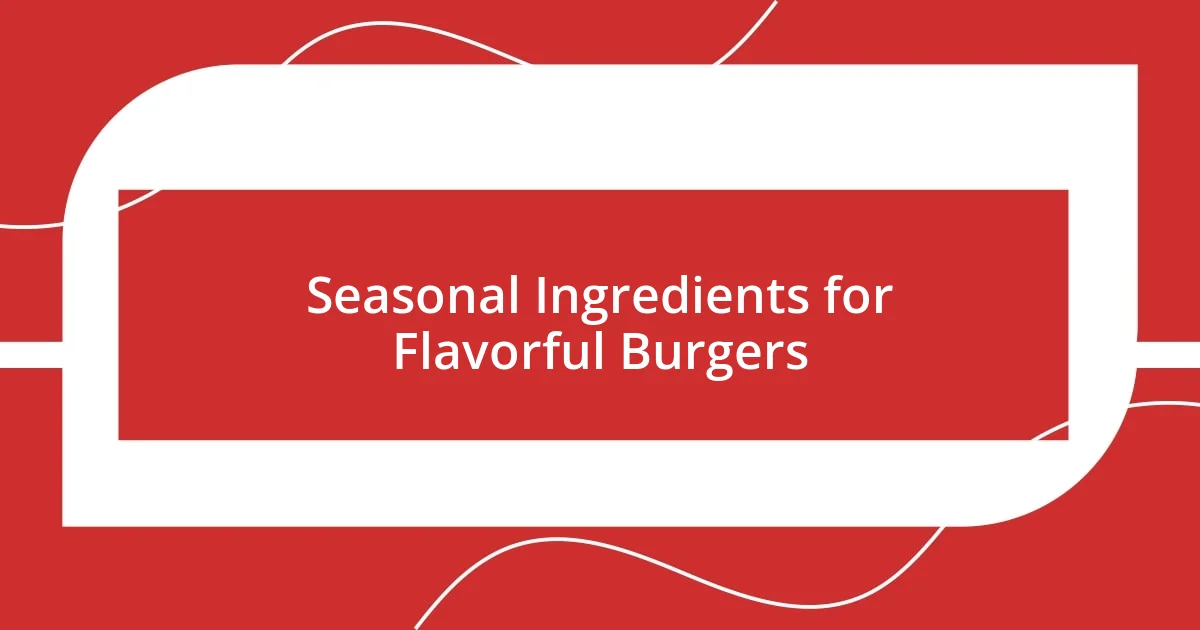Key takeaways:
- Using local ingredients enhances the quality and flavor of meals while fostering a sense of community and pride in supporting local farmers.
- Building relationships with local producers through farmers’ markets and community-supported agriculture enriches the shopping experience and promotes sustainability.
- Showcasing and sharing the stories behind local ingredients enhances the dining experience, creating deeper connections and conversations around food.

Understanding Local Ingredients Benefits
Using local ingredients offers a vivid connection to the community. I remember attending a farmer’s market where I tasted the juiciest tomatoes I’d ever had. The vendor shared how they grew them right in my neighborhood. Isn’t it amazing to think that the flavors I love come from just down the street?
When I select local produce, I feel a sense of pride knowing I’m supporting local farmers. It’s not just about taste; it’s also about building relationships with the people behind the food. Have you ever thought about how your food choices impact someone’s livelihood? For me, choosing local feels like being part of a greater story.
The freshness of local ingredients truly enhances the quality of my burgers. I’ve noticed that a grass-fed beef patty paired with locally sourced lettuce and specialty cheese creates a flavor explosion. Don’t you love that feeling when each bite reflects the essence of the community? It’s not just a meal; it’s an experience that brings joy and connection to my table.

Identifying Sources for Local Ingredients
When I started my journey with local ingredients, identifying reliable sources was an adventure of its own. I vividly recall wandering through my neighborhood, discovering hidden gems like a family-run farm and artisan cheese shop that I’d previously overlooked. Connecting with these local producers transformed my shopping experiences into meaningful exchanges.
Here are some practical tips I’ve found helpful in identifying sources for local ingredients:
- Visit local farmers’ markets; they’re treasure troves of fresh produce.
- Explore community-supported agriculture (CSA) programs for regular deliveries of local goods.
- Engage with friends and neighbors to share their recommendations.
- Check local food co-ops that prioritize sourcing from nearby farms.
- Follow social media accounts of local farms or food artisans for updates and specials.
By diving into these avenues, I’ve built relationships that enrich my kitchen, making each meal feel like a collaboration with the community.

Choosing the Right Local Farms
When it comes to choosing the right local farms, I believe it’s essential to ask the right questions. During one of my visits to a local farm, I realized the importance of understanding farming practices. I spoke with the farmer about their methods, and I was thrilled to learn they practiced sustainable farming. This kind of transparency made me feel confident about sourcing my ingredients from them. Have you ever been curious about how your food was grown? It can change the way you think about each meal.
Finding the perfect farm often means taking the time to explore various options. I remember the excitement of visiting a new farm for the first time, taking in the sights and smells of fresh produce, and chatting with the farmers about their specialty crops. Each interaction enriched my understanding of what goes into growing food. When I finally tried their heirloom tomatoes in a burger, I was blown away by their sweetness and depth of flavor.
Moreover, supporting local farms isn’t just beneficial for my taste buds; it strengthens the fabric of our community. I feel it’s crucial to choose farms that align with my values, such as ethical treatment of animals and organic practices. By asking questions and doing my research, I can make choices that not only taste better but also feel right. There’s a connection that develops when you know the source of your food, don’t you think?
| Farm Type | Key Features |
|---|---|
| Family Farms | Traditional methods, often organic, high-quality fruits and vegetables |
| Community-Supported Agriculture (CSA) | Direct support from consumers, seasonal produce, and unique varieties |
| Artisan Farms | Specialty products like cheeses and cured meats, often small batch |
| Organic Farms | Strictly regulated practices, emphasis on sustainability and environmental health |
| Why Choose? | Understand your preferences—whether for taste, ethics, or supporting local economies. |

Seasonal Ingredients for Flavorful Burgers
When it comes to making seasonal burgers, I’m always in awe of how ingredients change with the seasons. I vividly remember a summer evening when I crafted a burger topped with ripe, juicy peaches from a local farmer’s market. The sweetness of the peaches paired with tangy goat cheese just elevated the whole experience. Have you ever tasted a burger that made you feel like summer was captured in every bite?
As autumn rolls around, I look forward to incorporating hearty ingredients like squash and kale. One memorable fall, I experimented with roasted butternut squash and crispy sage on a burger, and let me tell you, it was a game-changer. The earthy flavors complemented the meat perfectly, and it felt like a warm hug on a chilly day. Seasonal ingredients really allow for creativity and the fun of experimenting with different tastes and textures.
I find winter is the perfect time to embrace root vegetables, especially in a burger. There’s something magical about a warm, spiced beet burger topped with a bright cranberry sauce. I remember serving this at a gathering, and everyone was surprised by how the sweetness of the beets transformed into a savory delight. Have you thought about how seasonal shifts influence your burger creations? It’s amazing how nature provides just what we need throughout the year, inspiring us to try something new and delicious.

Incorporating Local Ingredients into Recipes
Incorporating local ingredients into my burger recipes opens up a world of flavors. When I drove out to a nearby farm last spring, I stumbled upon a treasure trove of vibrant wildflowers that they use for natural garnishes. I can still recall the crunch of the fresh, edible flowers I sprinkled on my burgers. It added not only a pop of color but a unique, peppery flavor. Have you ever thought about garnishing with something other than standard lettuce? It can completely transform your meal.
I also love exploring local cheeses and meats. One evening, I made a burger featuring a smoky cheddar from a local artisan farm. The rich, creamy texture perfectly balanced the spiced beef patty. I remember my friends’ surprised reactions when they took a bite; they couldn’t believe the difference quality local cheese made. Have you experienced the richness of locally sourced dairy? It’s like a flavor revelation!
And I’ve found joy in using fresh herbs as well. A few summers ago, I planted basil from a local nursery in my backyard. The first time I sliced that aromatic basil for a burger topping, I felt a sense of pride knowing it came from my own garden. Each bite burst with freshness, reminding me of those lazy summer afternoons spent tending to my plants. Doesn’t it make you feel more connected to your food when you’ve grown it yourself? Incorporating local ingredients not just enriches the taste but creates meaningful connections to our meals.

Sustainability Practices with Local Ingredients
When I think about sustainability practices with local ingredients, I often reflect on the journeys I take to farmers’ markets and local farms. A few months back, I participated in a community-supported agriculture (CSA) program, and it was incredible to see where my food was coming from. This connection encouraged me to make mindful choices, knowing that every purchase helps support local farmers and reduces the carbon footprint from transportation. Have you ever visited a farm and felt that real connection to the land? It’s a feeling that stays with you.
Using local ingredients not only benefits the environment but also strengthens our communities. I once joined a volunteer day at a nearby farm where we helped with the harvest. It was rewarding to see how our efforts translated directly into the meals we prepared later that week. Each bite of that burger made from ingredients I had personally helped harvest tasted even better, knowing that I had played a role in that sustainable process. Isn’t it amazing how food can bring communities together and create a sense of shared purpose?
Moreover, I take great comfort in knowing that my choices influence the local ecosystem positively. By sourcing grass-fed beef from a nearby ranch, I not only support humane farming practices but also reduce the impact on land degradation caused by industrial farming. I remember one particular rancher explaining how their methods enhance soil health and biodiversity. When I choose local, I’m not just thinking about taste; I’m contributing to a more balanced and sustainable ecosystem. Doesn’t it feel good to know that every burger I serve is part of a larger effort towards environmental stewardship?

Showcasing Your Local Burger Creations
I love to showcase my local burger creations by arranging them in a way that tells a story. For instance, I recently crafted a burger that features seasonal ingredients, topped with pickled radishes I made from a friend’s garden surplus. The bright colors alongside the juicy patty drew immediate attention when I served it at a backyard barbecue. Don’t you think that showcasing the beauty of local produce can make a meal not just delicious but visually stunning too?
When I plate my burgers, I strive to highlight the local elements. One time, I experimented with a slider platter featuring mini burgers, each representing different local farms. One had garlic aioli made from farm-fresh garlic, while another was topped with roasted tomatoes from a neighbor’s greenhouse. It was exciting to see my friends guess which ingredient came from where. Have you ever shared a meal that sparked conversation about its origin? It creates an experience that connects everyone to the bounty around us.
I find inspiration in sharing not just the taste but the story behind each ingredient. Recently, I made a special burger featuring heirloom tomatoes from a local festival. I told my guests about the farm and the farmers who poured their passion into growing those tomatoes. When I saw their faces light up, it became clear: knowing the story behind what we eat adds profound meaning to the dining experience. Don’t you agree that food brings us closer, creating connections not only through taste but through shared narratives?















